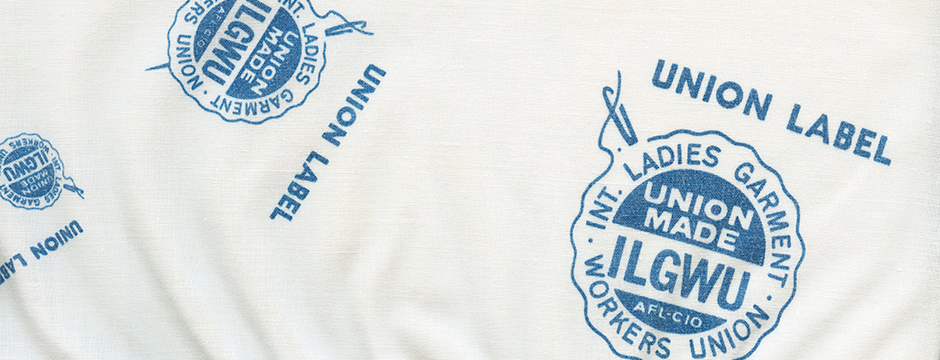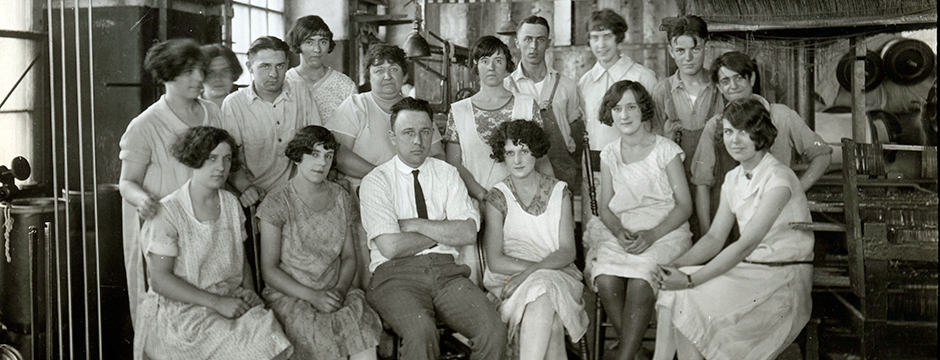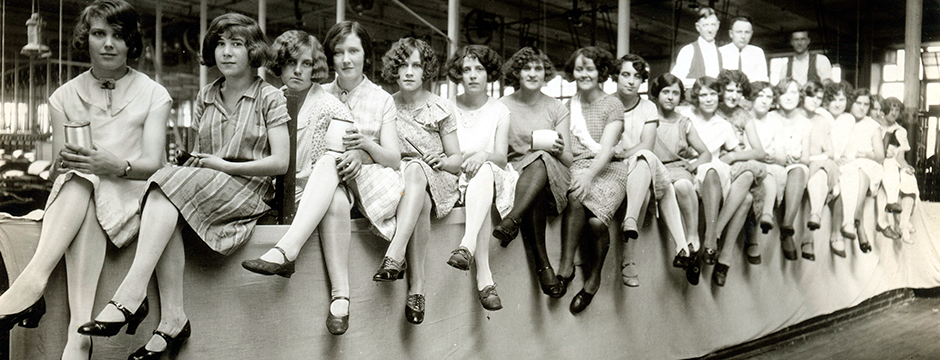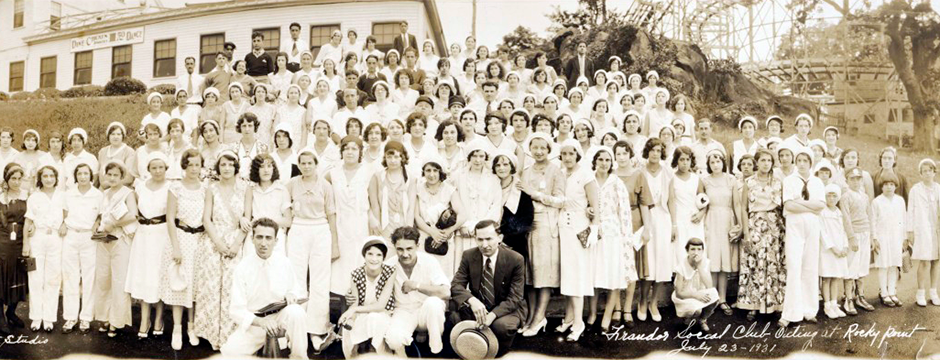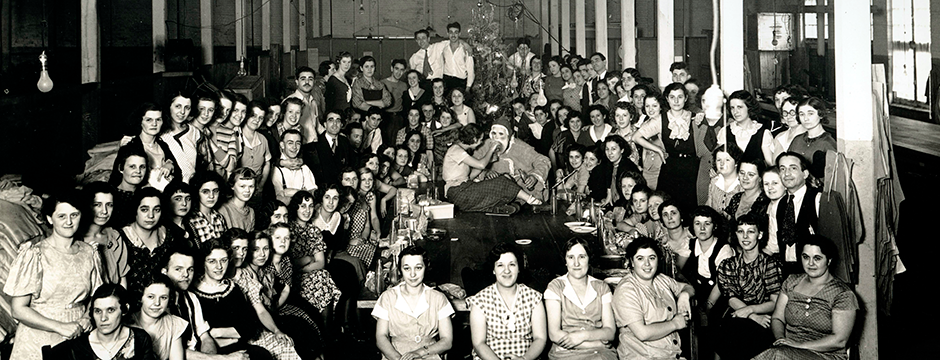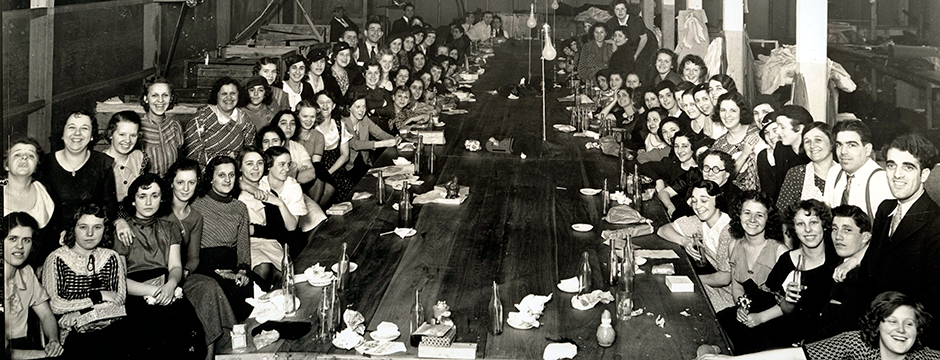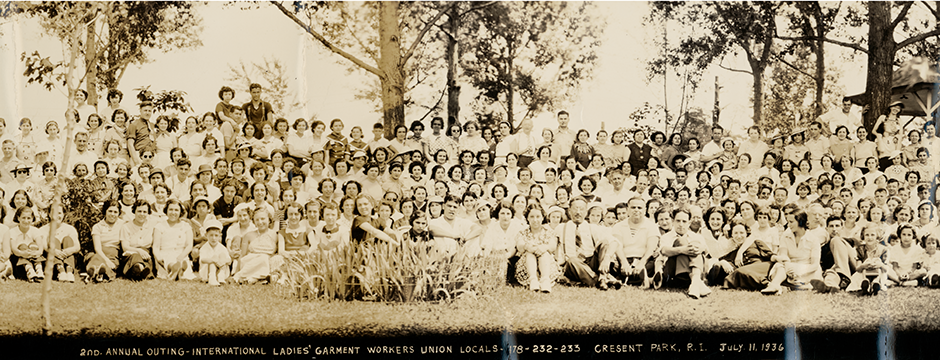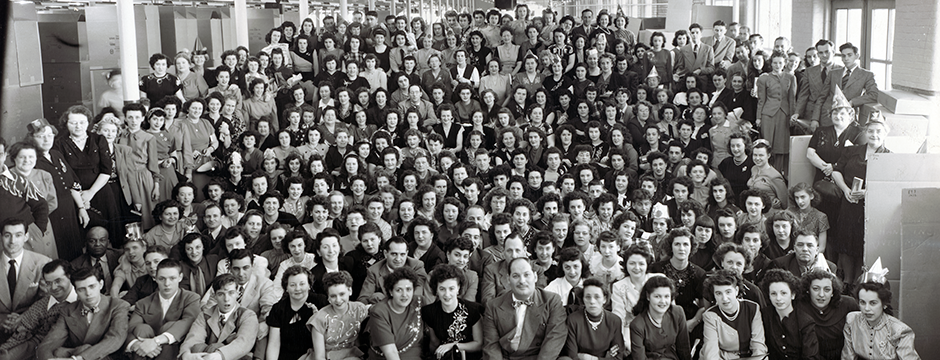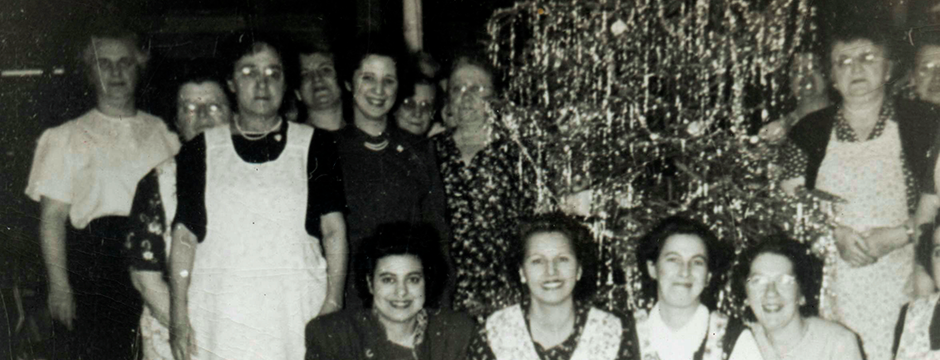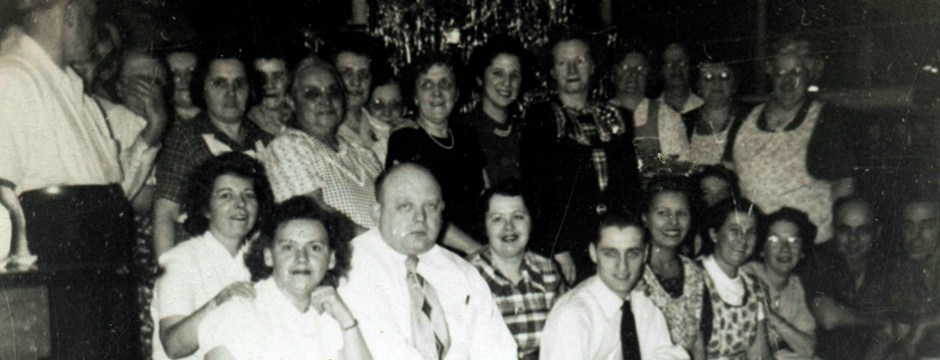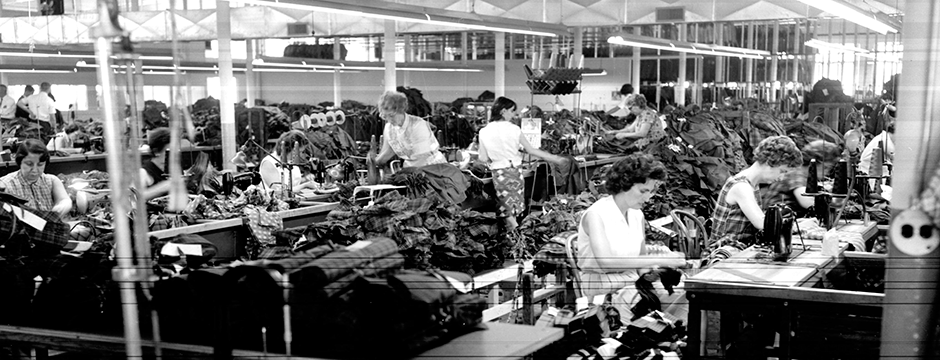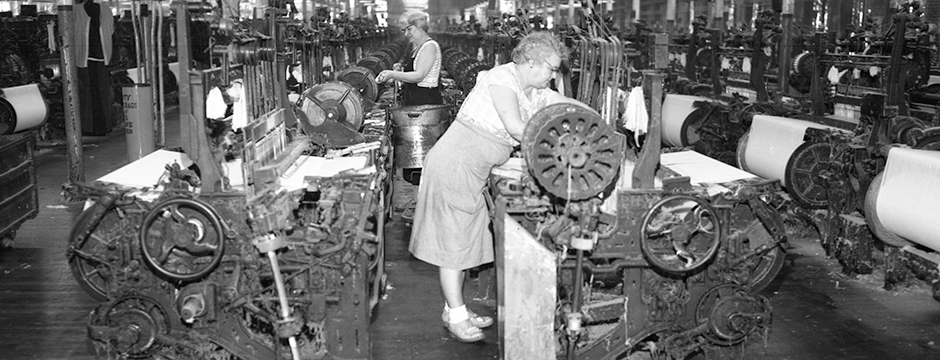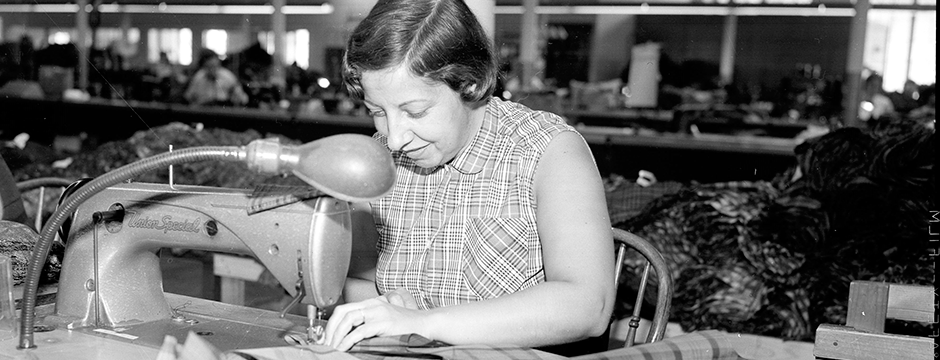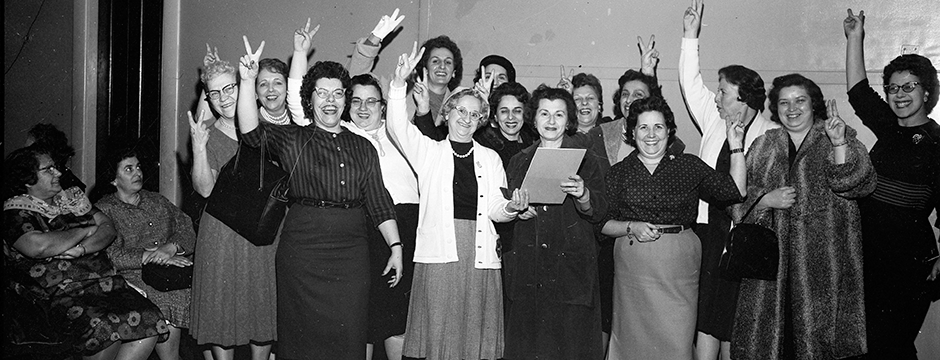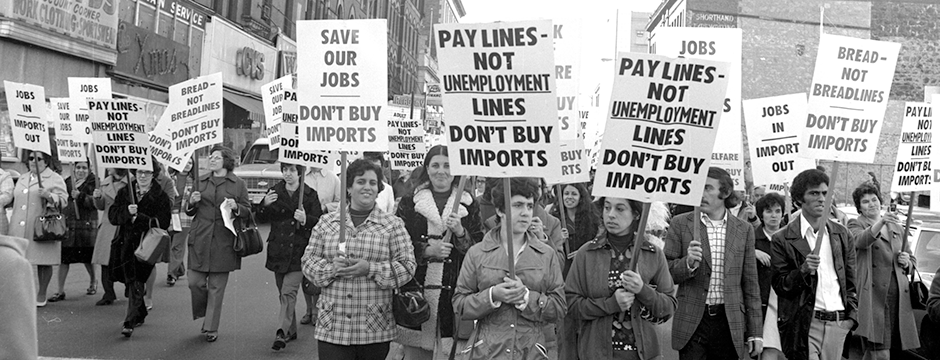Welcome to the Fall River Historical Society’s online exhibit,
Women at Work:
An Oral History of Working-Class Women in Fall River, Massachusetts 1920-1970.
Fall River Fabric Samples Gallery Related Ephemera Plymouth Sportswear Company, Inc.
Women at Work documents the lives of a group of working-class women in the city of Fall River during the middle decades of the twentieth century. Their stories provide a first-hand account of labor issues and everyday life during a tumultuous era in the city’s history.
It was a time of change, hardship, and recovery, when the city and its residents faced the decline, and ultimate collapse, of the textile industry; the early depression years of the late 1920s; the Great Depression years of the 1930s; and the rise of the female-dominated manufacturing and needle-trade industries.
The women profiled in this exhibit are of Azorean Portuguese, English, French-Canadian, Lebanese, and Polish descent. The progeny of immigrant ancestors who were drawn to the “Spindle City” by the promise of work and betterment, they are interwoven through marriage to form the warp and weft of the fabric that is the city of Fall River.
The interviews provide an opportunity for participants to explore, evaluate, and interpret their individual lives through conversation and reflection. Interviewees address questions that focus on their childhood and adolescence; work life and leisure activities; marital status; roles as mothers, homemakers, and breadwinners; family relationships; religion; the impact of unions and strikes; health issues; and finally their old age.
None of these women knew each other socially, yet their stories reflect a collective commonality of civic, family, socio-economic, emotional, and generational experiences. They walked the same streets, worked in many of the same factories, and persevered through Fall River’s economic transition from the world’s largest producer of cotton cloth to a major garment and manufacturing center.
The oral histories of Women at Work tell a Fall River story unique to the time, events, and culture of a city determined to re-establish itself.
But memories fade, and life is fleeting. A glance at the obituary section of local newspapers makes one acutely aware of the loss of important history as this generation passes. Women at Work captures those voices and stories, preserving them as primary sources for the benefit of present and future generations.
Additional interviews and supplemental material will be added to this ongoing exhibit periodically.
Informal extemporaneous remarks by President Franklin Delano Roosevelt at Fall River, Massachusetts, October 21, 1936
“I was glad to hear about the better conditions in Fall River for I know very well that the depression started here long before 1929…. I am grateful to all of you men and women for the courage that you showed through all those difficult years and I am confident that in the future that courage will be rewarded by better conditions.”
Franklin Delano Roosevelt Papers, File 988
FDR Presidential Library and Museum
When President Franklin D. Roosevelt made this optimistic prediction during a New England campaign swing, the city of Fall River, Massachusetts, had lived through the worst effects from the collapse of the textile industry and had started the long road back to economic recovery.
The fifty years covered in this study begins with the deindustrialization of the textile industry in the 1920s or “the depression” as referred to by President Roosevelt. The stories tell of how Fall River reindustrialized in the 1930s led by the factory and garment sectors. This ended in the 1970s with a second period of deindustrialization as American factory and garment workers faced an uncertain economic future due to globalization and foreign competition.
The women interviewed for this oral history program were born between 1916 and 1937, and grew up in homes where unemployment was routine and sacrifice was expected. They came of age during the Great Depression and World War II, then prospered during the postwar period and into the 1970s. Now, through Women at Work, they are able to reflect on their lives and past experiences.
Deindustrialization (1920-1930)
In 1911, Fall River, the so-called “Spindle City”, hosted the Cotton Centennial, a celebration of the city’s textile industry, with President William Howard Taft in attendance. The city, with a population of over 120,000, was, at that time, home to 111 cotton manufacturing companies that employed nearly 40,000 wage earners. But storm clouds were on the horizon.
While the 1920s roared in the rest of the country, Fall River’s textile mills confronted competition from southern factories and an uninterrupted decline in print cloth prices.1
The mills of Fall River had built their business primarily on one product — print cloth. In 1910, the city’s largest employer, the American Printing Company, employed 6,000 workers and was the world leader in the production of print cotton cloth.
In 1923, the city witnessed the first wave of mill closures and mergers. The following year, the American Printing Company opened a new plant in Kingsport, Tennessee, moving much of its operation there, eliminating many Fall River jobs in the process.
With the collapse of print cloth prices, Fall River began a fifteen-year decline during which seventy-three mills and three-fourths of the city’s industrial capacity was liquidated. The years 1928 and 1929 brought more crippling blows: a disastrous fire in the city’s downtown, labor unrest, and the stock market crash.
Reindustrialization: Power Looms to Power-Stitching (1930-1940)
By the 1930s and the Great Depression, many more mills were out of business, and employment opportunities for Fall River’s textile workforce shrunk by seventy percent, with only nine thousand jobs remaining.
In a devastating measure, Fall River declared bankruptcy in 1931 and was in state receivership for a decade. These years saw many of the city’s mills occupied by numerous smaller companies, primarily garment manufacturers traditionally based in New York City. Investors were attracted to New England, and more specifically Fall River, by the lure of inexpensive factory space, often advertised by the Chamber of Commerce as free factory space. An additional lure was an eager workforce in dire need of jobs.
The growth of manufacturing during the 1930s in Fall River was abetted by the passage of New Deal labor legislation such as the National Labor Relations Act (aka the Wagner Act), which established the legal right of workers to organize, to join labor unions, and to bargain collectively with their employers. Furthermore, in a city with a long history of trade unionism emerged “new unionism”: the establishment of the International Ladies Garment Workers Union (ILGWU) and the Amalgamated Clothing Workers of America (ACWA).
By 1940, there were only seventeen textile companies in operation in Fall River. The city’s new bedrock industry was the factory and garment industry, employing twenty percent of the workforce, eighty percent of which were female.
Reindustrialization Continues (1941-1970)
State receivership ended in June 1941. Fall River had put its financial house in order and was ready to start again.
The new beginning coincided with World War II. A key industry during this period was the Firestone Rubber and Latex Company, Inc. Establishing their Fall River operation in 1937 on Water Street in former American Printing Company buildings, Firestone was a key defense industry, employing 2,600 of Fall River’s workers.
The postwar years saw the continued supremacy of the factory and garment industry. The high point of ILGWU membership was in 1961, when there were more than 17,000 members in the Fall River area. Business was good with a thirty-five-hour work week, overtime pay, union health care, and union training and education programs.
Deindustrialization Again (1970-Present): Fall River Today – Lessons Learned
The last quarter of the 20th century would be marked by another bout with deindustrialization, and Fall River, like many other industrial sites in the United States, fell victim to globalization and foreign competition.
This time, the road back would take longer and would involve collaborative efforts by private, government, and education partners to diversify the economy, redesign and upgrade the city’s infrastructure, and renovate area assets to cultivate existing and emerging industries. The goal today is to build on manufacturing, green technology, the life sciences, transportation, professional services, and a creative economy.
Examples of niche industries that are currently operating in Fall River and manufacturing products that are “MADE in the USA” are: John Matouk & Co., Inc. (luxury linens); Merida LLC (hand-finished rugs); and Frank Clegg Leatherworks (handcrafted leather bags).
Along with long-time industrial giants like Duro Textiles, LLC (textile fabric finishers) and Borden & Remington Corporation (chemical manufacturing and distribution), and the new innovative technology companies that are located in the Fall River Industrial Park and the SouthCoast Life Sciences and Technology Park, the city of Fall River is, once again, writing a new story to tell.
________________
- A decade noted for the passage of the Eighteenth (prohibition) and Nineteenth (women’s suffrage) Amendments to the U.S. Constitution, and the Johnson-Reed Act establishing the immigration quota system (1924-1952).


